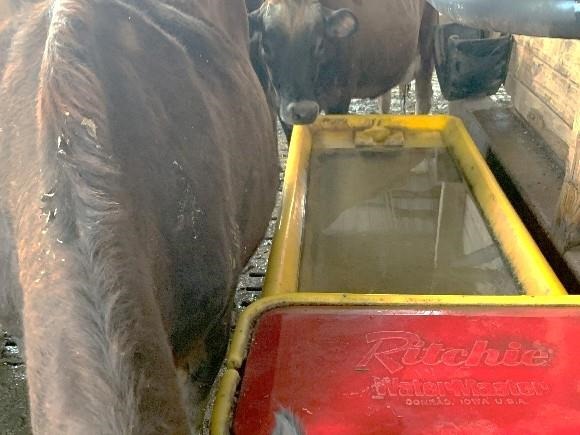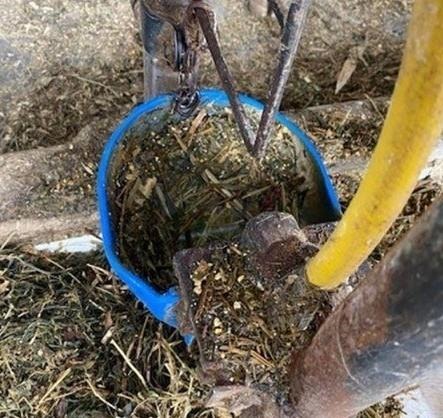By Carly Becker
How many times a day do you walk through the dairy barn? On these daily barn walk-throughs do you remember to check the cleanliness of the water bowls or water tanks? Oftentimes, the availability and cleanliness of water is overlooked. What about your heifers and cows out on pasture? Do they have clean drinking water available that is easily accessible? This is a reminder that water is the cheapest and most vital nutrient for dairy cattle. Providing an appropriate supply of clean water is essential for basic bodily functions such as urination, respiration, and heat dissipation. Milk is 87% water and a dairy cow’s body water content ranges from 56% to 81% of their body weight. Per unit of body weight, a high-producing dairy cow is reported to have a greater water requirement compared to any other land mammal. If available, a lactating dairy cow will consume 30 to 50 gallons of water a day. When experiencing heat stress water intake can double making it even more important that water is provided. The size of the cow, production level, amount of dry matter consumed, temperature and relative humidity of the environment, temperature of the drinking water, quality and availability of the water, and amount of moisture in her feed will influence how much water a cow drinks throughout the day. Ensuring all cows have an ample, clean water supply is a vital management practice.

Figure 1. Example of a clean water tank in a dairy barn.
Water is supplied to dairy cows from two primary sources: 60% to 80% from drinking water and 25% to 35% from water or moisture in feed. Some factors that can affect water intake include dry matter intake, milk production, dry matter content of the ration, environmental temperature, and sodium intake. Water can be lost via saliva, urine, feces, milk, a limited amount from sweating, and through evaporation on body surfaces and the respiratory tract. Cows in tie stall barns drink about 14 times a day compared to cows in loose housing that only drink about 7 times a day. A dairy cow spends between 10 to 60 minutes each day drinking water. Cows can drink a lot of water very quickly. However, if the waterer space is not large enough or the water flow rate is too slow cows may have to wait to meet their water needs or they may not get to drink at all during that visit to the waterer. Designing a water system that is easily accessible and allowing for at least a 30 gallon per minute flow rate into the tank is best to ensure that water does not become limited at active drinking times. For water bowls, typically as flow rate increases drinking time decreases and overall water intake increases per day. Providing an appropriate flow rate for water bowls is just as important as in the water tank. Supplying enough water stations throughout the barn can help ensure that even the more submissive cows in the group will have a chance to drink. When overstocking dairy barns be sure there is enough water space for that number of cows.
Some general space recommendations for drinking areas in a dairy barn include (Tyson, 2020):
- 2 to 4 inches of perimeter space per cow
- Optimal water tank height ranges from 24 to 32 inches
- Water depth should be a minimum of 3 inches
- At least 2 watering locations per pen to prevent dominant cows from guarding the water tank area
- Provide enough space at the waterer so that 20% of the cows in the group can drink at the same time
- Water tank located within 50 feet of the feed bunk or at every crossover in a freestall barn and should be immediately accessible after returning from milking
- Heifers should have access to one appropriately sized water space per 20 animals
- The same recommendations go for cows and heifers on pasture
An important fact to remember is that cows will drink 30% to 50% of their total daily water intake within 1 hour or so after milking. This time is also a peak period for cleaning milking equipment; therefore, water flow going to the waterers may decrease. Water flow rates should be observed at these heavy use times and altered accordingly. Cows should never have to wait for the water tank or bowl to fill up. Limiting the availability of fresh, clean, good quality water, even for just 2 hours on pasture, can decrease milk production quicker than a deficiency in any other nutrient.
Waterers that are placed in an area that allows cows to drink and eat at the same time can boost dry matter intake and milk production. If placed in a separate location from the feed area, cows should travel no more than 15 to 20 stalls or 50 feet to access a water source. Alley width should be taken into consideration when choosing a place for a water tank as well. There should be enough space for the water tank, the length of the cow drinking, and additional width for one- or two-way traffic to pass through while other cows are drinking.
Water quality is another important factor to monitor a couple times a year. A water sample can be collected from your farm and sent to a laboratory to be evaluated for chemical and physical aspects such as minerals, nitrate-nitrogen, total dissolved solids, and bacteria content. Table 1 shows levels of mineral concentrations in water sources that could potentially lead to animal issues. Total dissolved solids over 1,000 mg/L can lead to performance issues depending on the contaminant causing the increased levels. Levels over 3,000 mg/L will cause the water to have an “off" taste resulting in decreased water intake. Milking equipment should be cleaned with water that has zero total coliform bacteria per 100 mL or water. If manure contaminates a water source the presence of E. coli bacteria can occur and can cause serious issues in cows. To prevent manure contamination of water, use a raised base around water bowls and tanks. In addition, frequently cleaning water bowls and tanks can prevent bacteria build up. Waterers should be emptied and cleaned with a weak chlorine solution and refilled with fresh water at least weekly to maintain water freshness and quality. This includes calf and heifer water buckets, bowls, and tanks. Contact your county Extension office if you are interested in getting a water sample tested.

Figure 2. Example of a water bowl that is filled with feed and should be cleaned out.
Table 1. Common mineral concentration concerns in water sources that could lead to possible animal problems
| Mineral | Concentration (mg/L) |
|---|
| Copper | Greater than 1 |
| Iron | Greater than 0.30 |
| Manganese | Greater than 0.05 |
| Magnesium | - |
| Nitrate/nitrogen | Greater than 20 |
| Sodium | - |
| Chloride | Greater than 250 |
| Sulfate | Greater than 1,000 |
| |
When it comes to water availability and spacing do not forget about calves and heifers. Water plays an important role in rumen development and should be offered to calves starting from day one. Calves might not drink any water at first but keeping it available will make them curious and may help them start drinking water sooner. Providing enough clean water for all ages of cattle on a dairy is essential for a productive herd and to ensure all animals are healthy.
Source : psu.edu